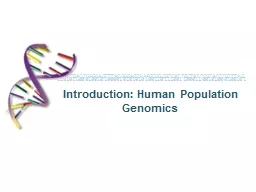

Introduction Human Population Genomics ACGTTTGACTGAGGAGTTTACGGGAGCAAAGCGGCGTCATTGCTATTCGTATCTGTTTAG Cost Killer apps Roadblocks How soon will we all be sequenced Time 2013 2018 Cost Applications ID: 578303
Download Presentation The PPT/PDF document "0101011000100101000010101010100110111001..." is the property of its rightful owner. Permission is granted to download and print the materials on this web site for personal, non-commercial use only, and to display it on your personal computer provided you do not modify the materials and that you retain all copyright notices contained in the materials. By downloading content from our website, you accept the terms of this agreement.
Slide1
010101100010010100001010101010011011100110001100101000100101
Introduction: Human Population Genomics
ACGTTTGACTGAGGAGTTTACGGGAGCAAAGCGGCGTCATTGCTATTCGTATCTGTTTAGSlide2
CostKiller appsRoadblocks?
How soon will we all be sequenced?
Time
2013?
2018?
Cost
ApplicationsSlide3
The Hominid LineageSlide4
Human population migrations
Out of Africa, ReplacementSingle mother of all humans (Eve) ~150,000yrSingle father of all humans (Adam) ~70,000yr
Humans out of Africa ~50000 years ago replaced others (e.g., Neandertals)
Multiregional Evolution
Generally debunked, however,
~5% of human genome in Europeans, Asians is Neanderthal,
DenisovaSlide5
Coalescence
Y-chromosome coalescenceSlide6
Why humans are so similar
A small population that interbred reduced the genetic variationOut of Africa ~ 50,000
years ago
Out of AfricaSlide7
Migration of HumansSlide8
Migration of
Humanshttp://info.med.yale.edu/genetics/kkidd/point.htmlSlide9
Migration of
Humanshttp://info.med.yale.edu/genetics/kkidd/point.htmlSlide10
Some Key Definitions
Mary: AGCCCGTACGJohn:
AGCCCGTACGJosh: AGCCCGTACG
Kate:
AGCCCGTACG
Pete:
AGCCCGTACG
Anne:
AGCCCGTACG
Mimi:
AGCCCGTACG
Mike: AGCCCT
TACGOlga: AGCCCTTACG
Tony: AGCCC
TTACG
Alleles: G, TMajor Allele: GMinor Allele: THeterozygosity
:
Prob
[2 alleles picked at random with replacement are different]
2*.75*.25 = .375
H = 4Nu/(1+4Nu)
G/G
G/G
G/
T
G/G
G/G
G/G
G/G
T
/
T
T
/G
T
/G
Recombinations:
At least 1/chromosome
On average ~1/100 Mb
Linkage Disequilibrium:
The degree of correlation between two SNP locations
Mom
DadSlide11
Human Genome VariationSNP
TGCTGAGATGCCGAGA
Novel SequenceTGC
TCG
GAGA
TGC - - - GAGA
Inversion
Mobile Element or
Pseudogene
Insertion
Translocation
Tandem Duplication
Microdeletion
TGC
- -
AGA
TGCCGAGA
Transposition
Large Deletion
Novel Sequence
at Breakpoint
TGCSlide12
The Fall in Heterozygosity
H – H
POP
F
ST
= -------------
HSlide13
The HapMap Project
ASW African ancestry in Southwest USA 90
CEU Northern and Western Europeans (Utah) 180CHB Han Chinese in Beijing, China 90CHD Chinese in Metropolitan Denver 100
GIH Gujarati
Indians in Houston,
Texas 100
JPT Japanese
in Tokyo,
Japan 91
LWK Luhya in Webuye,
Kenya 100MXL Mexican ancestry in Los Angeles 90MKK Maasai
in Kinyawa, Kenya 180TSI Toscani
in Italia 100YRI Yoruba in Ibadan, Nigeria 100
Genotyping:
Probe a limited number (~1M) of known highly variable positions of the human genomeSlide14
Linkage Disequilibrium & Haplotype Blocks
p
A
p
G
Linkage Disequilibrium (LD):
D
= P(A and G) -
p
A
p
G
Minor allele: A GSlide15
Population Sequencing – 1000 Genomes Project
The 1000 Genomes Project Consortium
et al.
Nature
467
, 1061-1173 (2010) doi:10.1038/nature09534Slide16
Association Studies
Control
Disease
A/G
A/G
G
/G
G
/G
A/G
G
/G
G
/G
A/A
A/G
A
/A
A/G
A/G
A
/A
A
/A
AA
0
4
AG
3
3
GG
4
0
p
-valueSlide17
Wellcome Trust Case Control
Nature
447, 661-678(7 June 2007)Nature
464
, 713-720(1 April 2010)
Many associations of small effect sizes (<1.5)Slide18
Disease Clustering
DiseaseGenotyping
Multiple Sclerosis (MS)Illumina chip, 15K non-synon
SNPs
Ankylosing
Spondylitis (AS)
Autoimmune Thyroid
(ATD)
Breast Cancer (BC)
Rheumatoid Arthritis (RA)
Affy
500K array
Bipolar Disorder (BD)
Crohn's
Disease (CD)
Coronary
Artery (CAD)
Hypertension (HT)
Type 1 Diabetes (T1D)
Type 2 Diabetes (T2D)
PLoS
Genet 5(12): e1000792. doi:10.1371/journal.pgen.1000792. 2009. Slide19
Disease ClusteringRA vs. ATD
RA vs. MSNo recorded co-occurrence of RA and MS
SNP - Allele
Gene Symbol
Genetic Variation Score (GVS)
RA (NARAC)
RA
AS
T1D
ATD
MS (IMSGC)
MS
rs11752919 - C
ZSCAN23
-3.48
-3.21
-9.39
1.10
0.70
3.25
2.99
rs3130981 - A
CDSN
-0.46
-1.00
-9.47
-4.94
0.33
10.00
13.41
rs151719 - G
HLA-DMB
-6.71
-4.77
-1.08
-13.63
0.34
8.58
17.76
rs10484565 - T
TAP2
25.52
8.37
1.34
15.74
-1.36
-0.56
-0.30
rs1264303 - G
VARS2
11.51
7.36
18.76
0.89
-1.76
-1.85
-1.75
rs1265048 - C
CDSN
6.59
2.97
50.13
6.34
-0.85
-2.39
-4.16
rs2071286 - A
NOTCH4
5.30
0.78
6.42
4.04
-0.03
-1.89
-2.45
rs2076530 - G
BTNL2
67.49
56.46
14.06
13.58
-6.41
-9.50
-18.52
rs757262 - T
TRIM40
14.58
9.11
6.27
1.56
-0.79
-2.05
-7.34Slide20
Ancestry Inference
?
Danish
French
Spanish
MexicanSlide21
Global Ancestry InferenceSlide22
Fixation, Positive & Negative Selection
Neutral Drift
Positive Selection
Negative Selection
How can we detect negative selection?
How can we detect positive selection?Slide23
Conservation and Human SNPs
CNSs have fewer SNPs
SNPs have shifted allele frequency spectra
Neutral
CNSSlide24
How can we detect positive selection?
Ka/Ks ratio
:
Ratio of
nonsynonymous
to
synonymous substitutions
Very old, persistent, strong positive selection for a protein that keeps
adapting
Examples
: immune response, spermatogenesisSlide25
How can we detect positive selection?Slide26
Long Haplotypes –iHS test
Less time:
Fewer mutations
Fewer
recombinations